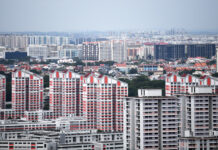SINGAPORE: It has been a challenging year for the global economy and particularly hard for countries that are trade-dependent and deeply integrated into global supply chains.
Singapore’s small, open economy is a prime example of an externally-oriented economy that had a rather demanding year, with its annual output on track to grow by only 0.5 per cent in 2019.
There are several intertwined factors that have contributed to the global growth slowdown and have weighed on Singapore’s trade-related sectors.
READ: Income growth slows in Singapore; median salary now above S$4,500: MOM report
LOOKING BACK: TRADE WAR SHOCKS
Over the course of the year, the trade conflict between the US and China escalated more than what was anticipated at the beginning of the year.
In the early months of 2019, the economist consensus did not foresee a scenario where tariffs would be raised multiple times followed by retaliatory measures. We simply expected rationality to prevail and for the trade dispute to be maintained at less harmful levels.
READ: Commentary: The US and China would like nothing more than to end the trade war
READ: Commentary: The US-China trade war has been all bark and no bite
Nevertheless, trade policy surprises ended up being the main unforeseen external shock that weakened the global economy in 2019.
Global economic activity has slowed and trade volumes have collapsed due to the US-China trade conflict and its ripple effects through tightly integrated supply chains.
Tariffs and persistent trade-related uncertainties not only led to contracting trade, but also adversely impacted confidence and business investment.
Workers at a manufacturing facility in Singapore. (Photo: AFP/Roslan Rahman)
Muted export sector activity together with softer capital investment has translated to weaker real GDP growth around the world.
CHINA’s STRUCTURAL SHIFTS
Softer global demand and trade have put additional downward pressure on China, which has already been on a slowing growth trajectory.
The Chinese economy is gradually transitioning to a new phase of economic development in which activity is increasingly powered by consumer spending and the services sector instead of fixed investment and the industrial sector, which can be volatile.
READ: Commentary: Has China given up on pursuing growth?
The structural change is leading to somewhat slower — yet better quality — real GDP growth over the coming years.
China’s weaker growth dynamics is one of the key reasons behind another trend that is adversely impacting exporters, particularly in Asia; the global downturn in the electronics sector.
The sector’s recessionary conditions have been further amplified by a longer replacement cycle of smartphones, making it difficult for Asian semiconductor exporters to manage production lines.
READ: Commentary: China lifted 850 million people out of poverty but now faces bigger challenges
FILE PHOTO: A researcher plants a semiconductor on an interface board during a research work to design and develop a semiconductor product at Tsinghua Unigroup research centre in Beijing, China, February 29, 2016. REUTERS/Kim Kyung-Hoon
THE IMPACT ON SINGAPORE
The aforementioned entwined developments — the US-China trade dispute, weaker global and Chinese economic growth, and the electronics sector downturn — have jointly impacted Singapore.
Declining trade and muted global demand have created a challenging economic environment for Singapore.
The country’s export sector is a key engine of growth, with exports of goods and services being equivalent to 176 per cent of GDP in 2018, one of the highest in the world.
READ: Commentary: In this tough job market, retraining alone is no silver bullet
Moreover, softer Chinese demand has had an adverse impact as China is one of Singapore’s main export destinations; Hong Kong and mainland China combined is the destination for over a quarter of Singapore’s shipments abroad equivalent to over 20 per cent of Singapore’s annual GDP.
In addition, Singapore is highly integrated into the regional supply chains, with intermediate goods accounting for more than half of its total exports.
READ: Commentary: Can the RCEP save the Singapore economy?
Singapore Maritime Week draws members of the international maritime community for conferences and events that reflect the vibrancy and diversity of the city-state as a global hub port. Photo: Shutterstock
Finally, the global electronics sector recession is adding to Singapore’s challenges.
Electronics is the biggest component of Singapore’s exports. Integrated circuits alone account for almost 40 per cent of Singapore’s total exports.
The trade-related turmoil and elevated uncertainties triggered an increasingly broad-based monetary easing bias around the world, Singapore included, marking another development not anticipated by many at the beginning of the year.
Indeed, central banks globally have acted rather decisively in order to prevent weaker confidence from fully translating into postponed investment, hiring decisions and delayed consumer spending.
Meanwhile, monetary policymakers are increasingly calling for simultaneous fiscal policy action by governments to complement the monetary stimulus efforts.
READ: Singapore’s financial system still resilient, but MAS urges vigilance amid rising risks
FILE PHOTO: A view of the Monetary Authority of Singapore’s headquarters in Singapore June 28, 2017.REUTERS/Darren Whiteside
Indeed, higher public outlays will likely provide additional support to the global economy as we move into 2020.
LOOKING FORWARD TO 2020
Determined action by policymakers in various countries to support the economy is unquestionably a welcome development.
Unfortunately, though, Asian authorities have only limited ability to influence the trajectory of regional economic growth as the key driver of the outlook is external in nature — policy decisions coming from the White House.
As we approach 2020, a key risk to the economic outlook is a major policy surprise, or rather a policy misstep, that could potentially lead to a broad-based loss of confidence, higher risk aversion, tighter liquidity, and a broadly based market correction.
READ: Next Budget will be ‘strong, suitable to the state of the world and what the Singapore economy needs’: PM Lee
While it is difficult to determine what that surprise would be (hence it is a surprise!), it could take the form of a broadening of US protectionism toward other countries, perhaps through auto import tariffs; geopolitical turmoil; or a domestic US policy shock related to the ongoing impeachment inquiry.
Indeed, as we enter into 2020, the only certainty continues to be elevated uncertainty.
Tuuli McCully is Head of Asia-Pacific Economics at Scotiabank.




